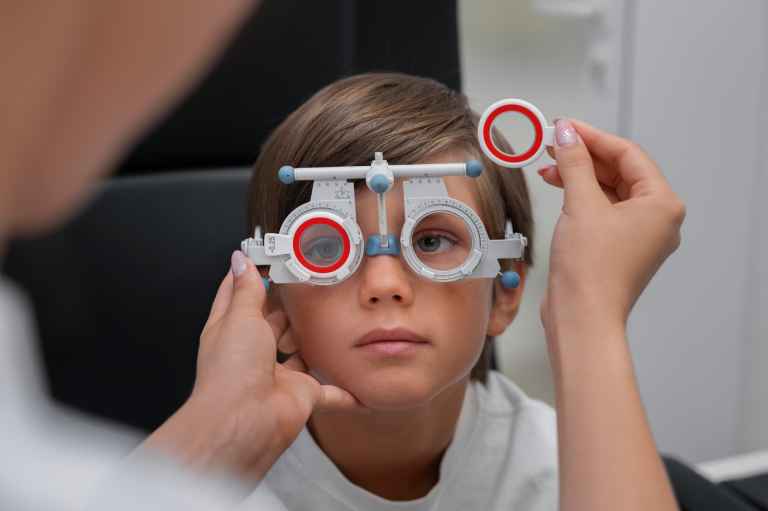It’s time we steer the conversation to eye care with a special focus on children in India. “Why?” you may ask. The ‘Status of Child Eye Health in India’ report, launched on World Sight Day in 2020, sheds light on alarming numbers.
In India, approximately 1 in every 1000 children aged 0-15 years experiences blindness. It’s surprising to learn that 270,000 children in India are blind. This represents the highest count of visually impaired children found in a single nation.
Eye-opening, isn’t it? This is where pediatric eye care enters the picture.
Common Eye Concerns in Children
Children’s vision is increasingly important for their academic, sports, and social performance. Since it accounts for most of the learning, even a minor concern can have a significant impact on their lives. Here are some of the common eye concerns in children:
1. Refractive Errors
A child with refractive errors struggles to see objects at near distance, far distance, or, at times, both clearly. This group of errors includes the following concerns:
- Nearsightedness
- Farsightedness
Unfortunately, refractive errors go unnoticed until vision becomes too blurry. Even then, if left untreated, they can lead to lazy eyes. So, what are some of the signs you should look out for?
- Squinting
- Head tilting
- Headaches after visually demanding activities
- Sitting very close to the board or screen
Also Read: Refractive Errors: Understanding Myopia, Hyperopia, Astigmatism, and Presbyopia
2. Amblyopia
The other name for this condition is lazy eyes. It occurs when one of the eyes is weaker and does not achieve normal visual function. Mind you, it is challenging to diagnose because your child may be relying too much on the ‘good’ eye. Some of the signs you should watch out for include:
- Difficulty in reading, math, and sports
- Difficulty in attention and focus
- Closing an eye during tasks
- Rubbing an eye frequently
3.Convergence Insufficiency (CI)
CI is a binocular vision concern in which the two eyes are unable to focus on a near object. As a result, it affects near vision and eye-muscle coordination. It is often misdiagnosed as ADHD, autism, and dyslexia since these children often struggle with reading, writing, comprehension, and attention.
You should be mindful of the following signs in this case:
- Blurred or double vision
- Difficulty reading and concentrating
- Uses a finger or ruler when reading
- Avoidance of close work
- Poor hand-eye coordination
- Motion sickness
4. Strabismus
Strabismus, in simple words, refers to the misalignment of eyes. It can be either present at birth or acquired later on in life due to muscle problems or focusing errors. It is commonly called “crossed eyes” or “wandering eyes”, and one or both the eyes in this condition either turn –
- Outward
- Inward
- Upward
- Downward
This condition can drastically lead to other concerns, such as depth perception.
5. Depth Perception
Depth perception lets you gauge the distance between two things. But wait. If each of our eyes sees objects slightly different and at different angles, how can you accurately gauge the depth? Your brain. It merges 2 images into one 3D image.
Now, how does this concern arise? Some of the common reasons behind depth perception include:
- Strabismus
- Amblyopia
- Concerns with optic nerve
- Trauma to one of the eye
Early Detection
A child’s first eye exam should be scheduled around the six-month mark. It is recommended that youngsters receive another eye exam when they turn three and then another one before starting first grade. They need to go in for another eye checkup between the ages of five and six.
Children who are old enough to attend school should have their eyes checked every two years, even if corrective lenses are not necessary. If a child needs corrective lenses, such as glasses or contacts, they should get an eye checkup at least once a year or more frequently if their doctor suggests it.
Treatment Options
There are a variety of treatment options available to correct some of these concerns early on.
- Prescriptive glasses for refractive errors
- Eye drops and occlusion therapy for Amblyopia
- Convergence exercises are often recommended for treating convergence insufficiency
- Surgery may be necessary for strabismus
Also Read: The Benefits of Vision Therapy for Children and Adults
Wrapping Up
Early detection and treatment of children’s vision concerns is crucial to their learning, growth, and safety.
Parents should pay special attention to the signs mentioned above and keep a check on how their kids are using digital devices. Additionally, they should not overlook the importance of making sure their child wears their prescriptive glasses and protective eyewear when playing sports.
If problem persists, book your appointment at Shree Ramkrishna Netralaya, one of the best eye hospitals in Mumbai.

